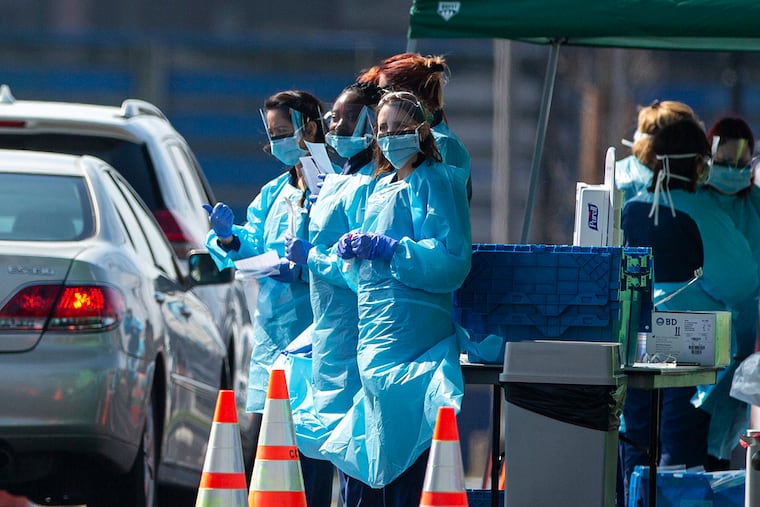COVID-19 testing was always problematic. Here’s why it has become even less useful.
Problems with PCR tests for COVID-19 used to dominate the news. Then came vaccines.

Before the advent of COVID-19 vaccines in December, molecular diagnostic testing was the key to diagnosing, tracing, and containing the spread of the coronavirus.
Molecular testing was a feeble weapon against the pandemic, like using a squirt gun on a three-alarm fire.
Now, with about 40% of Americans fully vaccinated, cases, hospitalizations, and deaths have fallen dramatically — and so has the value of molecular testing.
That’s why the Centers for Disease Control and Prevention declared earlier this month that most fully immunized people can shed masks, resume regular activities, and skip getting tested for the coronavirus unless they have symptoms.
The CDC’s relaxed guidance — coming after months of urging everyone to keep up precautions — has been cheered, but also faulted as confusing, potentially dangerous, long overdue, or premature.
Let’s unpack the science and sensibleness of dialing back diagnostic testing.
The problem of inaccuracy
Molecular tests, which use a high-technology platform called polymerase chain reaction, are the gold standard for diagnosis because they are the most accurate. Regulators require the tests to correctly diagnose at least 95% of infected samples in lab validation studies.
But PCR tests are not perfect. The accuracy can be thrown off by contamination, sample mix-ups, data entry errors, and more.
Accuracy also varies depending on the prevalence of infection and the purpose of the test, as Los Angeles researchers explained in March in the Journal of Occupational and Environmental Medicine.
Consider the situation at the peak of the pandemic, when 10% or more of people getting tested had infections. If the tests correctly diagnosed 95% of those infections, that still meant 5% of infected people were missed. They got “false negative” results and, instead of isolating, possibly spread the virus to others.
Vaccination has reshaped the risks. Now, the prevalence of infection is much lower, and PCR tests are often used to screen unvaccinated people who have no COVID-19 symptoms — for example, college students — or vaccinated people with symptoms of what may be just a cold. If only 1% of those tested are actually infected, then the chance of false alarms, or “false positive” results, goes way up.
The epidemiological calculations get wonky, but here’s the bottom line of the screening scenario, according to the Los Angeles researchers, led by Cedars-Sinai Medical Center physician Glenn D. Braunstein: For every 10,000 people tested, 100 (1%) are infected. Of the infected, 95 are correctly diagnosed and five are missed. But an additional 198 will be incorrectly diagnosed as infected. Thus, the probability that people with a positive result truly have COVID-19 is low — only 32%.
The CDC doesn’t get into all this on its website, nor mention that the federal government has spent billions of dollars picking up the testing tab. But the agency recognizes that false alarms can lead to unnecessary, disruptive quarantines. So in general, fully vaccinated people who have been around someone with COVID-19 “do not need to stay away from others or get tested” unless symptoms appear. Nor do they need routine screening testing unless it is required by, say, an airline.
The problem of detecting harmless cases
Here’s another wonky issue that reduces the value of PCR testing as the pandemic eases.
PCR works by generating millions of copies of viral genetic material, called RNA, even if only trace fragments of RNA are in the patient’s sample. The process involves repeated heating cycles, typically no more than 40. If no virus is detected after 40 cycles, the sample is negative.
But the amount of virus in a sample is directly linked to the number of cycles needed to detect it (more virus, fewer cycles), a number called the cycle threshold. The amount of virus is also linked to how contagious the person is likely to be (less virus, less contagious), as explained by MITMedical, a Massachusetts Institute of Technology publication.
If the cycle threshold is high, the infection “may be a subclinical case, meaning that your viral load is so low that you are not infectious and cannot spread the virus to other people, including those in your household,” the article says.
Mounting evidence suggests that vaccinated people who get infected are usually subclinical cases.
These so-called breakthough infections are also uncommon and mostly mild or asymptomatic, the CDC says. Between January and April of this year, 101 million people were fully vaccinated and 10,262 breakthrough infections were reported. Of these patients, about 1,000, or 10%, needed hospitalization, including 289 who died.
Given the remarkable effectiveness of the vaccines at preventing serious disease, the CDC this month announced it would monitor and publicly report only the breakthrough infections that lead to hospitalizations or death. In response, anti-vaccine activists posted on social media that the change is an effort to conceal the true number of vaccine failures.